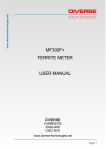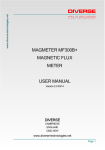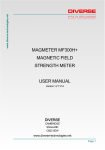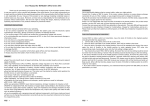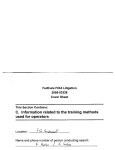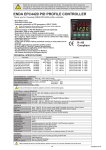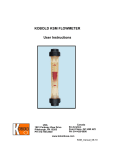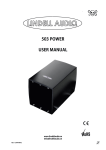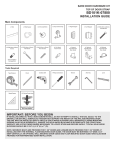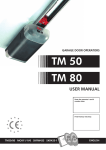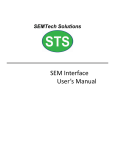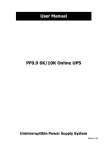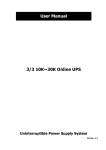Download MF500M+ manual
Transcript
www.diverse-technologies.net DIVERSE MAGMETER MF500M MAGNETITE METER USER MANUAL CAMBRIDGE ENGLAND CB22 5EW www.diverse-technologies.net Page 1 www.diverse-technologies.net Contents INTRODUCTION FIRST TIME - QUICK START OPERATION OPERATION - OPTIONS CALIBRATION AND PIPE OCCLUSION MEASUREMENT TECHNIQUE SPECIFICATION LIABILITY CALIBRATION AND REPAIR DISPOSAL AND RECYCLING Page 2 www.diverse-technologies.net Introduction Thank you for purchasing MF500M. Before using the unit, please read these instructions carefully. If you are uncertain about any aspect of its operation, please contact Diverse our contact details are at the end of this manual. The MF500M is designed to measure magnetite in nonmagnetic stainless steel pipes, particularly cooling pipes in power stations. The MF500M Magnetic Field Meter uses a force technique to detect and quantify levels of magnetic material (particularly magnetite) contained within stainless steel pipes. Because of this, it is IMPORTANT that the pipe walls are not magnetic. Page 3 www.diverse-technologies.net First time, quick start The unit requires 4 AA cells which should be installed in the battery compartment on the rear of the housing. Measurements are made by bringing the metallic front of the probe into contact with the outside of the pipe. The probe is sensitive to gravity and should be zeroed in the same orientation as the measurement. Zero the probe before each measurement Quick start 1. Plug in the magnetite probe. 2. Load the AA batteries in to the battery compartment ensuring that the polarity is correct 3. Press the power button (central yellow button), the unit will switch on. 4. Hold probe away from pipe and depress button on probe until a long beep is heard (zero value stored) 5. Take probe to pipe and press button, a double beep will indicate measurement has been taken. For a more detailed description of functionality see the operation section. Important note The probe end should be placed no closer than 5mm to steel or iron as this will stress the detector. Page 4 www.diverse-technologies.net Operation Controls There are 5 buttons on the meter and one on the probe with functions as given in table 1. Table 1. Button functions Button Colour Function enter yellow up green down green right green left green Probe button black (probe) long press to turn unit off, short press to turn on or select subsidiary function( e.g. view records etc.) scroll through records in <view records> menu, toggle display type in <measure> menu scroll through records in <view records> menu, toggle display type in <measure> menu select main menu (scroll through options) and leave subsidiary menus select main menu (scroll through options) and leave subsidiary menus short press take measurement and record, long press store current value as zero/offset Button presses are accompanied by audible confirmation as follows: ● single beep - menu select and at power on ● double beep - measurement recorded ● triple beep - unit powered off ● long beep - zero/offset value updated Page 5 www.diverse-technologies.net Operation - Options Menus <Measure> This is the normal mode of operation There are two display modes for this menu which can be toggled using the up or down keys. Data is updated approximately every second The first mode displays the measured value, currently stored offset and signal (difference) on the bottom line. The next available record number is shown on the top line. The second display mode estimates the amount of pipe occlusion based on the current measured and offset values (note there are a number of assumptions in these estimates see section on calibration). Note that data displayed on the first of these display formats is what is recorded on a short probe button press. <View records> Press enter to view stored records (4 records shown, 1 record per line). Enter toggles between two display formats. Default format is record number, measure value, stored offset and signal (difference between measured and zero/offset). Alternative format gives record number and signal. Use up and down buttons to scroll through stored records. Continuous press of up or down scrolls records. Left and right buttons leave view record menu. Page 6 www.diverse-technologies.net Operation - Options <Clear records> Press enter to clear records and set next record pointer to start of memory. <About> Gives software version number <Calibrate> The instrument has two calibration factors used when estimating pipe occlusion, gain and packing factor. The following section gives details on how these factors are calculated. This menu option gives the user the opportunity to modify the calibration factors. The up and down keys are used to select the factors and the left and right keys increase and decrease the selected factor. With gain or packing selected press enter to store the values and exit to the main menu. To revert to the factory calibration press enter button with default selected. Page 7 www.diverse-technologies.net Calibration and pipe occlusion A magnetite sample was used for calibration, This was a cuvette 1cmx1cmx1.5cm packed with magnetite flakes. A force measurement was recorded with the centre of a long side of the cuvette 5mm from the centre of the probe measurement surface (to simulate a pipe wall thickness). This value is taken for the factory calibration gain and the software assumes that this value corresponds to an occlusion of 75% in a tube of 40mm inner diameter and 5mm wall thickness. By measuring the mass of the cuvette the density of the magnetite flake sample was calculated and compared to the density of solid magnetite. This gave a packing factor of 48%. This factor is used in the display of occlusion for solid magnetite. Calibration settings can be altered using the <Calibrate> menu. User offset adjustment The offset has been set to be nominally 50 counts with the probe held horizontally. In the unlikely event that the offset needs to be adjusted then this can be carried by adjusting the potentiometer. Gently peel back the calibration label to access the potentiometer using a small screwdriver, clockwise will take the offset positive, anticlockwise will take the offset negative. Replace the calibration label after adjustment. Note that the meter’s range is nominally 0 to 1022 force units. Page 8 www.diverse-technologies.net Measurement technique The meter provides a number that increases with the amount of magnetite present. The following aspects should be noted: 1. The meter is sensitive to gravity so it is important that the meter is zeroed, away from the pipe, in the same orientation as the measurement to follow. 2. The meter is designed to work with a space between the probe cap and magnetite. If the meter is too close to magnetite (or indeed a ferritic sample) then a raw reading of 1022 will be displayed. 3. Magnetite distribution will effect the measured value i.e. a small amount of material close to the probe will give the same signal as a larger amount further away. Magnetite tends to accumulate on the corners of cooling pipes where the pipes turn from vertical to horizontal. At these points the pipe fills up from the bottom rather than homogeneously as per our occlusion calculations. Under these conditions we would recommend probing the underside, the side and the top of the pipe around the circumference. Due to the proximity of other pipes the underside and top of the pipes may not be accessible so we recommend probing positions A, B and C in the Figure 2. As the pipe fills up the signal is expected to increase on A first then B and finally C. Note the meter must be zeroed between measuring points A, B and C but not between the same orientations on the same or different pipes. Page 9 www.diverse-technologies.net Measurement technique We recommend that a number of pipes are surveyed and the measurements correlated with magnet tests and x-ray data. From these results a measurement rational should be evident that allows pipes with a particular occlusion to be readily identified using the meter. An alternative formal rote is described in the following section. Figure 2. Pipe measurement Page 10 www.diverse-technologies.net Calculation of Magnetite from MF500M readings Preamble The magnetite meter measures the force on a powerful rare earth magnet caused by the ferritic component of the magnetite. It is a prerequisite of this technique that the containing pipe is stainless steel which is not magnetic. In making the measurement the instrument has a sensor that has some compensation for the probe orientation in respect to gravity forces. Clearly the magnetite could be in any amount at any point in the pipe, but in reality there are only really 2 likely scenarios. Firstly the pipe is fully filled and in normal use there is continuously flowing water filling the tube. In this case the magnetite is likely to be evenly deposited on the inside surface. (Note this is not guaranteed and could be affected by turbulent flow or surface finish attributes). The second scenario is that the magnetite has accumulated on one side of the pipe. This can be due to a horizontal pipe that is not fully filled, or accumulation of flakes of magnetite building up under gravity. The measurement rote attempts to identify which type of deposit is in place and then estimate the deposit thickness from the measurement. Before starting the probe should be placed in a position at least 1m from any magnetic material instrument should be zeroed. This removes any constant offset in the measurement system to be removed from all subsequent measurements. Page 11 www.diverse-technologies.net Calculation of Magnetite from MF500M readings Measurement - phase 1 Placing the probe on any point on the surface of the pipe slowly move the probe around the surface of the pipe keeping the face of the probe at a tangent to the pipe surface. noting the points where the reading is the highest and lowest Smax and Smin. Now we have to decide whether the magnetite is coating the whole of the inside surface of the pipe or just a sector (as would happen with a horizontal pipe where either flakes of magnetite have accrued or the water has not fully filled the pipe). From the analysis we have done, if the ratio Smax/Smin < 1.5 then the accrual might be deemed to be evenly coated. Measurement - phase 2: even coating A graph attached is the reading from the instrument for a range of thickness and pipe sizes (internal diameter), so in order to estimate the coating thickness locate the reading on the y axis, trace horizontally to the curve for the pipe size under test and then trace vertically down to the horizontal axis and read off the estimated thickness. Measurement - phase 2: sector coating Starting at the point where the signal is a maximum (Smax) with a chalk mark to indicate this position, slowly move the probe round the pipe maintaining the probe at a tangent to the Page 12 www.diverse-technologies.net Calculation of Magnetite from MF500M readings pipe surface until the signal has fallen to Smax/2. Mark the pipe again. Repeat the prodecure in the other direction. In each case note the angle from the Smax position take the average of these as θ (the half angle). Defining the sector thickness t to be the thickest point of a sector bounded by the inside of the pipe and a straight line across the arc, and, R is the radius of the inside of the pipe. The estimate of sector thickness, t is: t = R * (1 - cos(θ)) Ratio of sector thickness to radius is: q = 1 - cos(θ) —–––––( 1 ) (0 < θ < 90o) Occlusion, f (fraction) For θ in radians: f = ( θ - (sin(2θ)/4) )/ π For θ in degrees: f = ( θ∗π/180 - sin(2θ ∗ π/180)/4 )/ π —–––––( 2 ) Expressions 1 and 2 are plotted below together with a simple linear approximation that could be appropriate for quick assessments. Page 13 www.diverse-technologies.net MF500M Specification Reading range 0 to 1022 force units Occlusion Technique 0 to 100% Uses net magnetic force to identify magnetite and magnetic material Accuracy Reading range: 0 - 1022 force units. These are arbitrary units, and each instrument needs to be calibrated to the specific pipe geometry and magnetite samples Can be zeroed at anytime - measurement technique requires unit to be zeroed in the measurement orientation Measurement independent of probe orientation provided it is zeroed first in that orientation Zero Probe orientation Gravity Zero removes gravity offset Display 4 lines of 16 characters Shows value and user interface messages Functions Raw force, occlusion for solid and broken magnetite 500 samples per second +/-5% assuming sample is degaussed Internal data sample rate Repeatability Probe size Detection Storage Probe cable length Calibration: Power: 20mm x25mm, 150mm long Detects the magnetic force between the sensing magnet and the magnetite. The signal is offset by an estimate of the gravitational force. Maximum of 20 records can be stored 1.5m typical Calibration is indicative only. Unit is supplied with a calibration sample of magnetite so that the instrument functionality can be verified 4 standard AA cells , typical lifetime 12 months. Continuous use 30 hours Instrument size: Weight in case: 165 x 100 x 50mm 1.3kg Environmental: Humidity Display update rate: Warranty 10 - 40C operating, 0 - 80C storage 0-90% non condensing 0.3 seconds 12 months Page 14 www.diverse-technologies.net Liability Diverse Technologies accepts no responsibility for the consequential losses arising from the ability or inability to use the equipment supplied. The limit of warranty is the repair or replacement of any faulty components, directly attributable to manufacturing defects, arising during the period of 12 months following purchase. This does not include damage resulting from incorrect operation of the instrument. Designed and manufactured by:Diverse Technologies & Systems Ltd. Zeromag House 46-48 Whittlesford Road Shelford Cambridge CB22 5EW UK Tel: +44 (0) 1223 84 44 44 Email: [email protected] http://www.diverse-technologies.net Page 15 www.diverse-technologies.net Calibration and repair The MF500M and probe is not supplied with a calibration certificate. It’s operation is indicative only to be used to determine the potential level of pipe occlusion. IMPORTANT This instrument uses magnetic force balancing and requires specific equipment to set the unit up for optimum operation. If the instrument requires repair this can only be undertaken at Diverse Technologies. If the MF500M requires repair, the unit should be returned to Diverse, there are no user serviceable parts. Page 16 www.diverse-technologies.net Disposal and Recycling This instrument should be deposed of in a responsible manner to allow the components within it to be recycled. The wheelie bin symbol shown here and on the product means that the product is classed as Electrical and Electronic Equipment and should not be disposed with other household or commercial waste at the end of its working life. The Waste of Electrical and Electronic Equipment (WEEE) directive (2002/96/EC) has been put in place in the EU to recycle products using the best recovery and recycling techniques to minimise the impact on the environment, treat any hazardous substances and avoid landfill. Business users should ensure that this product is not mixed with other commercial waste for disposal. Page 17

















